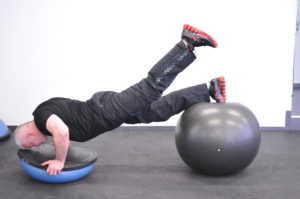BALANCE AS A DYNAMIC NATURE OF EFFICIENT MOVEMENT
The traditional understanding of balance as maintaining the centre of mass between the fulcrums (where the centre of mass, as an imaginary point, has its place inside the body) reflects the static understanding of this term.
In sports, the quick pace of performing the movement, the intensity of the workout, as well as athlete’s agility and mobility and the action mulitidirectionality, demand balance to be considered as a dynamic “structure”. In all of these sports, the centre of mass has its place outside the body and the athlete, being constantly put to the test, has to maintain their balance at all times. Creation of such unstable training conditions combined with an appropriate exercise program leads to improvement of many parameters that make athlete’s competetive efforts more effective.
During balance training, the organism of an athlete performs a great deal of senso-motoric work. The human body is full of neurosensory cells („detectors”, „minibrains”) which are located not only in muscles but also in tendons, ligaments etc. These sensors remain dormant until they have to make some kind of effort, as it is in the case of balance training. Untrained sensors work in a slower and less precise way than the sensors that do undergo training.

Balance is an ability that can, to a great extent, be developed.
Balance training enables to activate the nervous and the muscle system in order for moves to be carried out in a faster, more precise and more effective way.
BALANCE EXERCISES AS A FORM OF STRENGTH TRAINING
Balance training is a variant of strength training that is realised under conditions of disturbed balance and on unstable surfaces. Balance exercises stabilize the work of joints through elimination of weak kinetic chain links. In many situations that occur during sparring, effectiveness isn’t simply the outcome of applying maximal force. In most cases, the essential element is strong, force-generating muscle contraction which, at the same time, also has to be supported by stabilizing efforts of other muscles. Some of the muscles should also remain relaxed during this contraction.
Through balance training in which muscle contractions occur without conscious involvement of athlete’s will, the training immediately enters the phase of movement ‘automation’ which is characterized by spontaneous muscle and nervous system reactions.
BALANCE EXERCISES AS A FORM OF SPEED TRAINING
Developing the ability to maintain balance and to regain a stable position in a fast and natural way after losing it contributes to shortening the time needed to go from one movement sequence to another. Complex and opposing moves can be performed faster at that time, as the time between a concentric and an eccentric muscle contraction is considerably reduced.

BALANCE EXERCISES AS A FORM OF QUICKNESS TRAINING
Quickness is connected to speed training, however, it specifically concerns immediate, explosive taking of action in which dynamic moves of limbs play a key role. Quickness training is therefore not identical to shortening reaction time.
In martial arts, hockey, football and other direct competeive sports the control of balance has fundamental meaning. This applies especially to sports in which the body weight rests on one leg when performing an action or those in which the action itself means taking the opponent down or ground fighting or pushing off the play, etc characterized by simultaneous movement direction changes or fast and deep rotational movements of torso and of the whole body. A well-trained balance allows faster movement direction changes, makes proper execution of action easier and adds flow, as well as agility.


Leave a reply